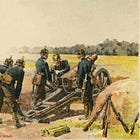Gallows Hill
An exercise from 1919
On 15 May 1919, the commanding officer of the Special Purpose Assault Detachment [Stosstrupp-Abteilung zur besondere Verfügung] of the Baltic Landeswehr issued orders for the conduct of a field problem. This exercise, which he scheduled for the following day, would the ability of the Assault Detachment to carry out an “attack with limited objectives.”
The Ground
The ground selected for the exercise consisted of two long ridges. These, which rose above the surrounding countryside by twenty meters or so, formed the walls of a valley.
The eastern ridge, known to the German-speaking inhabitants of Latvia as the Galgen-Berg [Gallows Hill], was home to a large number of graveyards. The western ridge, which might be described as a series of hills, was covered with trees.
At its widest point, the valley that separated the ridges extended, from east to west, a good six hundred meters. At its narrowest point, the corresponding distance measured five hundred meters or so. Thus, to the eyes of veterans of the recent World War, the valley resembled the patches of “no man’s land” that separated various positions that they had occupied from those held by their most proximate enemies.
The Force
The force taking part in the exercise consisted mostly of elements of the Assault Detachment. These were:
the detachment headquarters [Stab]
the 1st Squadron [1. Schwadron] (two rifle platoons, with four light machine guns)
the 2nd Squadron [2. Schwadron] (two rifle platoons, with four light machine guns)
the 4th (Machine Gun) Squadron [4. Schwadron] (three two-piece heavy machine gun platoons)
the 5th Squadron [5. Schwadron] (two rifle platoons, with four light machine guns)
the Escort Battery [Begleitbatterie] (two field gun platoons, each with two 77mm light field guns)
The 3rd Squadron [3. Schwadron] spent the night before the start of the field problem clearing the terrain within six kilometers of the western edge of the exercise ground of people and cattle. (This suggests that the exercise made use of live ammunition.)
The reserve of the attacking force consisted of the 5th Squadron [5. Schwadron] of the Assault Detachment and the Engineer Detachment [Pionier Abteilung] of the Landeswehr as a whole. (The latter is the only unit of mentioned in connection with the exercise that belonged to a battalion of the Landeswehr other than the Assault Detachment.)
Opposing Forces and Umpires
The one-page memorandum describing the exercise made made no provision for opposition forces. That said, symbols depicting, in red, three enemy weapons (two machine guns and a field gun) appear on the sketch-map sent out with the written instructions. (A copy of this sketch, which provided most of the information for the map posted at the top of this article, can be found below.)
The document makes provision for four umpires [Schieds-Richter]. These are:
the commanding officer of the Assault Detachment
the leader of the 5th Squadron
the Adjutant of the 5th Squadron1
the orderly officer [Ordonanz-Offizier] on the staff of the Assault Detachment2
Purpose
The exercise provided practice in two techniques. The first of these was the attack with limited objectives. (To this end, the exercise will include three minutes of preparatory fire.) The second will be the reduction of a strong point (presumably the blockhouse depicted in red) by teams armed with hand-grenades.
Source: Attachment to Detachment Order 51 [Anlage zum Abteilungs-Befehl 51] Bundesarchiv (R 8025/6) (Following the first link will take you to the copy of the document located at the Military Learning Library. The second link will take you to a digitized copy of the folder at the German Federal Archive that contains the document.)
For Further Reading:
In the armies of the German Empire, an Adjutant served as the senior (and, at times, only) staff officer of a battalion, regiment, or brigade. In other words, he was the chief-of-staff of an organization too small to rate a proper chief-of-staff [Stabs-Chef].
Not to be confused with an officer who deals in arms and ammunition, an Ordonanz-Offizier served as a “directed telescope” for the commander of a unit or formation. Thus, while the duties of an adjutant kept him close to his unit’s headquarters, those of an orderly officer often involved visits to higher, adjacent, and subordinate organizations.








